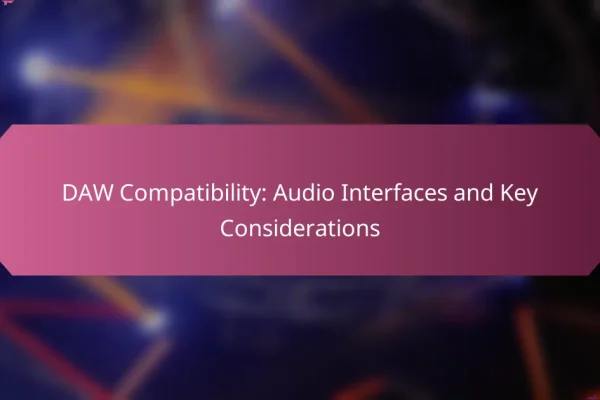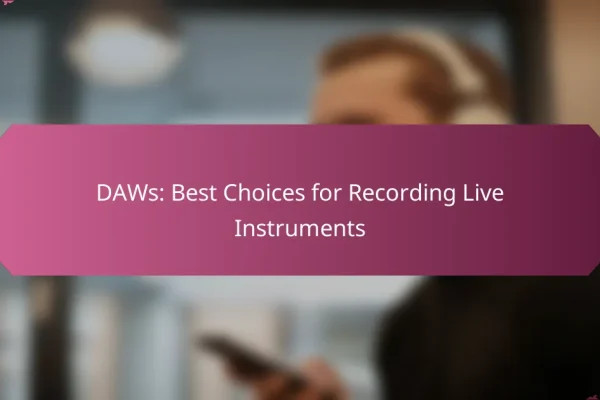How do DAWs enhance music creation in major cities?
Digital Audio Workstations (DAWs) significantly enhance music creation in major cities by providing musicians with powerful tools for recording, editing, and producing music. They streamline the creative process, making it easier to experiment with sounds and collaborate with others, which is crucial in vibrant urban music scenes.
Streamlined workflow
DAWs simplify the music production process by integrating multiple functions into one platform. Musicians can record, edit, and mix tracks without switching between different software, saving time and effort. This efficiency is particularly beneficial in fast-paced urban environments where time is often limited.
Using a DAW, artists can quickly arrange their compositions, apply effects, and make adjustments in real-time. This streamlined workflow allows for more experimentation and creativity, enabling artists to refine their sound without unnecessary delays.
Access to diverse sounds
DAWs offer access to a vast library of sounds and virtual instruments, which is essential for music creation in diverse urban settings. Musicians can explore various genres and styles by utilizing built-in samples or third-party plugins, enhancing their creative palette.
In major cities, where musical influences are abundant, DAWs allow artists to incorporate local sounds or global trends into their work. This flexibility enables musicians to create unique tracks that resonate with their audience while drawing from a rich array of sonic resources.
Collaboration tools
Collaboration is a key aspect of music creation in major cities, and DAWs facilitate this process through various online tools. Many DAWs include features that allow multiple users to work on the same project simultaneously, regardless of their physical location.
Musicians can share their work easily, receive feedback, and make real-time edits, fostering a collaborative environment. This capability is particularly valuable in urban areas where artists often collaborate across genres and backgrounds, leading to innovative musical outcomes.
What are the best DAWs for beginners in the UK?
For beginners in the UK, some of the best Digital Audio Workstations (DAWs) include GarageBand, FL Studio, and Reaper. These options are user-friendly, affordable, and provide essential features for music creation.
GarageBand
GarageBand is a free DAW available exclusively for macOS and iOS users, making it an ideal choice for beginners who own Apple devices. It offers a simple interface, a variety of virtual instruments, and built-in loops that facilitate music creation without prior experience.
Users can easily record audio, create MIDI tracks, and apply effects with just a few clicks. GarageBand’s intuitive design allows newcomers to focus on creativity rather than technical complexities.
FL Studio
FL Studio is a popular DAW among beginners and professionals alike, known for its flexibility and powerful features. It offers a range of pricing options, starting from a relatively low cost for the basic version, making it accessible for those just starting out.
The software includes a step sequencer, piano roll, and various plugins that help users create beats and melodies quickly. Its user-friendly interface and extensive online tutorials make it easy for beginners to learn and grow their skills.
Reaper
Reaper is a highly customizable DAW that offers a free trial and an affordable license, making it a great option for beginners on a budget. It supports a wide range of audio formats and has a robust set of features that can grow with the user’s needs.
While its interface may seem complex at first, Reaper’s extensive documentation and active community provide valuable resources for new users. Beginners should take advantage of the trial period to explore its capabilities before committing to a purchase.
How do professionals choose DAWs in the US?
Professionals in the US typically choose Digital Audio Workstations (DAWs) based on their specific needs, workflow preferences, and the type of music they create. Key factors include features, budget, and user interface, which can significantly influence their decision-making process.
Feature comparison
When comparing features, professionals often look for capabilities such as audio recording, MIDI support, virtual instruments, and effects. Some DAWs excel in live performance settings, while others are better suited for studio production. Popular options like Ableton Live, Pro Tools, and Logic Pro each offer unique features tailored to different workflows.
For example, Ableton Live is favored for electronic music due to its session view, while Pro Tools is the industry standard for audio editing and mixing. Evaluating these features against personal requirements is crucial for making an informed choice.
Budget considerations
Budget plays a significant role in selecting a DAW, with prices ranging from free options to several hundred dollars. Many professionals start with lower-cost or free versions to assess their needs before investing in more advanced software. It’s essential to consider not just the initial purchase price but also potential costs for plugins and upgrades.
For instance, while FL Studio offers a one-time purchase option, others like Logic Pro require an upfront investment but include a wealth of built-in instruments and effects, potentially saving money in the long run.
User interface preferences
User interface (UI) preferences can greatly affect a professional’s workflow and productivity. Some DAWs feature a more intuitive layout, making it easier for users to navigate and access tools quickly. Others may have a steeper learning curve but offer more customization options.
For example, GarageBand is known for its user-friendly interface, making it ideal for beginners, while Cubase offers extensive customization for advanced users. It’s advisable to try out demos or trial versions to find a DAW that feels comfortable and efficient for individual needs.
What are the key features of popular DAWs?
Popular Digital Audio Workstations (DAWs) offer a range of features that enhance music creation, including MIDI capabilities, audio recording, and editing tools. These features cater to different aspects of music production, making it essential to choose a DAW that aligns with your specific needs and workflow.
Logic Pro X – MIDI capabilities
Logic Pro X is renowned for its advanced MIDI capabilities, allowing users to create intricate compositions with ease. It offers a variety of MIDI editing tools such as quantization, velocity adjustments, and MIDI effects that enhance the creative process.
Additionally, Logic Pro X includes a vast library of virtual instruments and MIDI loops, making it suitable for genres ranging from electronic to orchestral music. Users can easily manipulate MIDI data to achieve desired sounds and arrangements.
Ableton Live – Live performance tools
Ableton Live is designed with live performance in mind, featuring unique tools that facilitate real-time music creation. Its Session View allows musicians to trigger clips and loops on the fly, making it ideal for improvisation and dynamic performances.
The software also supports a range of controllers and MIDI instruments, enabling seamless integration during live shows. This flexibility allows artists to adapt their performances spontaneously, enhancing the overall experience for both the performer and the audience.
Pro Tools – Industry standard
Pro Tools is widely regarded as the industry standard for audio recording and editing, particularly in professional studios. Its robust features cater to high-end audio production, including advanced mixing capabilities and support for a wide range of audio formats.
Many professionals prefer Pro Tools for its precision and reliability, especially when working on large projects that require extensive editing. However, it may have a steeper learning curve compared to other DAWs, making it essential for users to invest time in mastering its functionalities.
How do DAWs support remote collaboration?
Digital Audio Workstations (DAWs) enhance remote collaboration by providing tools that allow musicians and producers to work together from different locations. They enable seamless sharing of projects, files, and ideas, making it easier to create music collectively, regardless of distance.
Cloud storage integration
Many DAWs now feature cloud storage integration, allowing users to save and access their projects online. This means collaborators can upload their work to a shared cloud space, making it accessible to all involved parties. Popular options include services like Google Drive and Dropbox, which facilitate easy file sharing and version control.
When using cloud storage, ensure that all collaborators have the necessary permissions to access and edit files. It’s advisable to establish a clear naming convention for files and folders to avoid confusion and maintain organization.
Real-time editing features
Real-time editing features in DAWs allow multiple users to work on the same project simultaneously. This capability enables instant feedback and adjustments, fostering a more dynamic creative process. Some DAWs offer features like live chat or video conferencing to enhance communication during these sessions.
To maximize the benefits of real-time editing, ensure a stable internet connection and consider using DAWs that support low-latency performance. Familiarize all collaborators with the software’s tools and shortcuts to streamline the editing process and minimize disruptions.
What are the emerging trends in DAWs?
Emerging trends in Digital Audio Workstations (DAWs) focus on enhancing user experience and expanding creative possibilities. Key developments include AI-assisted music production, virtual reality integration, and cross-platform compatibility, which collectively aim to streamline workflows and foster innovation in music creation.
AI-assisted music production
AI-assisted music production is revolutionizing how artists create music by automating various tasks. These tools can analyze existing tracks, suggest chord progressions, or even generate melodies, allowing musicians to focus more on creativity. For instance, software like AIVA and Amper Music can compose original pieces based on user inputs.
When using AI in DAWs, consider the balance between automation and personal touch. While AI can enhance productivity, over-reliance may lead to a loss of unique artistic expression. Experiment with AI features to find the right mix that complements your style.
Virtual reality integration
Virtual reality (VR) integration in DAWs offers immersive environments for music creation and collaboration. With VR, users can visualize soundscapes and interact with virtual instruments in a 3D space, enhancing the creative process. Platforms like Oculus and HTC Vive are beginning to support DAW applications, providing new ways to experience music production.
To effectively use VR in music creation, ensure your hardware meets the necessary specifications and familiarize yourself with the software’s interface. This technology can be resource-intensive, so a powerful computer is essential for a smooth experience.
Cross-platform compatibility
Cross-platform compatibility allows musicians to work seamlessly across different devices and operating systems. This trend is crucial as it enables collaboration between artists who may use various DAWs, such as Ableton Live, Logic Pro, or FL Studio. Many DAWs now offer cloud storage options, making it easier to share projects and collaborate in real-time.
When choosing a DAW, check its compatibility with other platforms and devices you or your collaborators use. Prioritize software that supports file formats like MIDI and WAV for easy interchangeability. This flexibility can significantly enhance your collaborative efforts and workflow efficiency.







